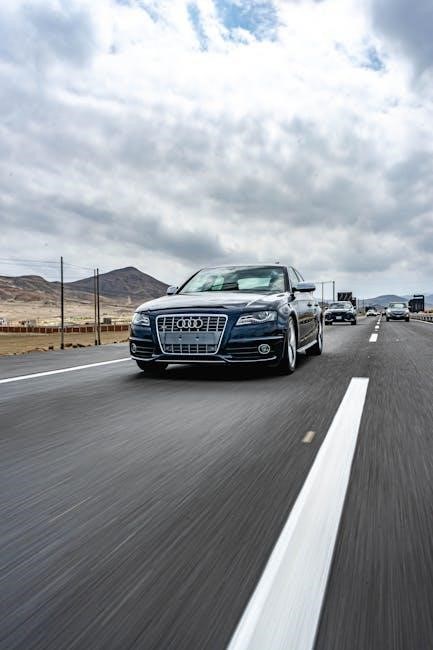Flat towing, or dinghy towing, has become a popular trend among RV enthusiasts, allowing them to bring a vehicle along for seamless exploration and convenience.
It involves towing a car with all four wheels on the ground, making it ideal for quick errands or adventures without detaching from the RV, ensuring a seamless experience.
Definition and Purpose
Flat towing, also known as dinghy towing, is a method of towing a vehicle with all four wheels on the ground. It allows RV enthusiasts to bring a secondary vehicle, such as a car or SUV, on their adventures without the need for a trailer. The purpose of flat towing is to provide convenience and accessibility, enabling travelers to explore new areas or run errands effortlessly. This technique is particularly popular among RVers who value the freedom to have a reliable vehicle available at their destination. The process involves equipping the towed vehicle with a hitch and braking system, ensuring a seamless towing experience.
Importance for RV Enthusiasts
Flat towing is a game-changer for RV enthusiasts, offering unparalleled convenience and freedom. It allows travelers to bring a secondary vehicle, ensuring they can explore remote areas or complete errands without the hassle of detaching a trailer. This method is especially valuable for those who enjoy spontaneity, as it provides a reliable means of transportation at their destination. For many RVers, having a flat-towed vehicle enhances the overall camping experience, combining adventure with practicality. The ability to seamlessly transition between driving the RV and the towed vehicle makes flat towing an essential skill for modern RV enthusiasts.

Benefits of Flat Towing
Flat towing offers convenience, cost-effectiveness, and versatility, enabling RV enthusiasts to bring a reliable vehicle for errands and exploration, enhancing their overall camping experience.
Convenience and Accessibility
Flat towing provides unparalleled convenience, allowing RVers to bring a vehicle for errands and exploration without the hassle of a trailer. With a towed car, you can easily detach and drive, eliminating the need for a separate shuttle vehicle. This accessibility is especially beneficial in remote campsites or urban areas where larger RVs may struggle to maneuver. Having a reliable towed vehicle ensures freedom to explore without relying on public transport or rental services. This convenience enhances the overall RV experience, offering flexibility and peace of mind for adventurers seeking seamless transitions between destinations.
Cost-Effectiveness
Flat towing is a cost-effective solution for RV enthusiasts, eliminating the need for expensive trailers or additional storage solutions. By towing a vehicle with all four wheels on the ground, you save on equipment costs and maintenance associated with trailers. Additionally, many flat-towable vehicles are fuel-efficient, reducing long-term expenses. This method also avoids the need for separate transportation arrangements, making it a budget-friendly option for extended trips. Over time, the savings from flat towing can significantly enhance your RV lifestyle, offering both financial freedom and practical convenience for adventurers on the go.
Versatility in Vehicle Choice
Flat towing offers remarkable versatility, allowing RVers to choose from a wide range of vehicles that suit their lifestyle and needs. Whether you prefer compact cars for easy maneuverability or larger SUVs for added space, there’s a flat-towable option available. Popular choices like the Jeep Wrangler and Ford Bronco are favorites due to their durability and compatibility. Additionally, many modern vehicles, including sedans and crossovers, can be flat towed, providing options for every budget and preference. This flexibility ensures that RV enthusiasts can bring along a reliable vehicle without compromising on their travel experience, making flat towing a practical and adaptable solution for adventures on the road.

Factors to Consider When Choosing a Flat Towable Vehicle
When choosing a flat towable vehicle, consider weight and towing capacity, transmission type and drivetrain, and manufacturer guidelines. Consult PDF guides or manufacturer manuals for compatibility.
Vehicle Weight and Towing Capacity
Vehicle weight and towing capacity are critical factors when selecting a flat towable vehicle. Ensure the vehicle’s weight does not exceed your RV’s towing limits to avoid damage or safety risks. Always consult the manufacturer’s guidelines for specific weight ratings and towing capacities. Exceeding these limits can lead to mechanical failure or compromised braking efficiency. A PDF list or guide can provide detailed information on compatible vehicles, helping you make an informed decision. Proper weight distribution and hitch setup are also essential for safe and efficient flat towing. Never overlook the importance of matching your RV’s capabilities with the vehicle’s specifications for a trouble-free experience.

Transmission Type and Drivetrain
Transmission type and drivetrain play a crucial role in determining a vehicle’s suitability for flat towing. Rear-wheel-drive (RWD) vehicles with manual or automatic transmissions are often ideal, as they can be towed without requiring complex setups. Front-wheel-drive (FWD) vehicles may also be compatible, but they often need additional equipment to avoid transmission damage. All-wheel-drive (AWD) and four-wheel-drive (4WD) vehicles can be more challenging, as their systems may not disengage properly for towing. Always consult the manufacturer’s guidelines to ensure the vehicle’s drivetrain is designed for flat towing. Modern vehicles with electronic transmissions or transfer cases may require special considerations to avoid damage during towing.
Manufacturer Guidelines and Recommendations
Adhering to manufacturer guidelines is essential when selecting a flat-towable vehicle. Many automakers provide detailed instructions in the owner’s manual regarding recreational towing. Terms like “recreational towing” or “flat towing” in the manual indicate compatibility. Some vehicles require specific procedures, such as engaging the neutral position or using a transmission pump to maintain proper lubrication. Ignoring these guidelines can lead to transmission damage. Always verify the manufacturer’s recommendations before towing. Additionally, some manufacturers offer PDF guides or lists of approved vehicles for flat towing, ensuring compliance and safety. Consulting the dealer or official resources is the best way to confirm a vehicle’s suitability for this towing method.
How to Find the Best Flat Towable Vehicles
Consult manufacturer guides, online databases, and forums to find reliable lists of flat-towable vehicles. These resources provide updated information to make an informed decision.
Using a PDF List or Guide
A PDF list or guide is an excellent resource for identifying flat-towable vehicles. These documents, often provided by manufacturers or towing experts, detail compatible vehicles and their towing requirements.
Many RV enthusiasts rely on comprehensive PDF guides to streamline their search. These lists are frequently updated to reflect the latest models and towing capabilities, ensuring accuracy and reliability.
When using a PDF list, always cross-reference the information with the vehicle’s owner’s manual. This ensures compliance with manufacturer guidelines and avoids potential damage to the vehicle.
Some guides also include tips for proper hitching and maintenance, making them a valuable tool for both novices and experienced tower. A reputable PDF list can save time and effort in finding the perfect vehicle for your towing needs.
Consulting Online Databases and Forums
Online databases and forums are invaluable resources for identifying flat-towable vehicles. Websites like MotorHome magazine and RV forums offer comprehensive lists and real-world experiences from seasoned enthusiasts.
These platforms provide detailed information on vehicle compatibility, towing setups, and manufacturer recommendations; They often include user-generated reviews and troubleshooting tips for common issues.
Forums, in particular, allow direct interaction with experts and fellow RVers, offering personalized advice tailored to specific needs. By leveraging these online resources, you can make informed decisions and avoid costly mistakes.

Combine this with official guides for a well-rounded approach to finding the perfect flat-towable vehicle for your RV adventures.

Checking Manufacturer Specifications
Consulting the manufacturer’s guidelines is crucial when determining if a vehicle can be flat towed. The owner’s manual typically includes specific instructions regarding towing capabilities, transmission types, and drivetrain requirements.
Some manufacturers explicitly state which models are approved for flat towing, while others provide detailed procedures to ensure safe towing without damaging the vehicle.
Ignoring these guidelines can lead to mechanical damage or void the vehicle’s warranty. Always verify the weight limits and towing configurations recommended by the manufacturer to ensure compatibility with your RV.
This step is essential for selecting a reliable flat-towable vehicle and ensuring a trouble-free towing experience.

Safety Considerations for Flat Towing
Ensure proper towing equipment setup, perform regular pre-towing checks, and maintain safe driving practices to prevent accidents and damage to both vehicles.
Pre-Towing Checks and Maintenance
Before flat towing, conduct a thorough inspection of your towing setup, including the hitch, tow bar, and safety cables, to ensure everything is secure and undamaged.
Check the tow vehicle’s brakes, tires, and suspension to confirm they can handle the added weight and stress of towing.
Inspect the transmission and drivetrain of the towed vehicle to ensure it’s properly prepared for flat towing, as specified by the manufacturer.
Verify that all electrical connections, such as taillights and brake lights, are functioning correctly to maintain safety on the road.
Regularly maintain the towed vehicle’s fluids and systems to prevent mechanical issues during transit.
Always consult the vehicle’s owner’s manual for specific pre-towing checks and maintenance requirements to avoid damage and ensure a smooth towing experience.
Proper Use of Towing Equipment
Using the correct towing equipment is essential for safe and effective flat towing. Always select a high-quality tow bar and hitch receiver rated for your vehicle’s weight to avoid equipment failure.
Ensure the towed vehicle is securely attached using safety cables and a brake system to maintain control during braking.
Double-check that all connections, such as the coupler and ball mount, are properly secured and tightened to prevent detachment while driving.
Use electrical connectors to sync the towed vehicle’s lights with the RV, ensuring visibility and compliance with traffic laws.
Never exceed the manufacturer’s weight capacity for your towing setup, as this can lead to safety hazards and equipment damage.
Regularly inspect all towing components for wear and tear, replacing them as needed to maintain reliability and safety on the road.
Safe Driving Practices

Safe driving practices are crucial when flat towing to ensure a secure and enjoyable experience. Always maintain a reduced speed to account for the added weight and length of your setup.
Increase your following distance to allow more time for braking and maneuvering.
Signal early and clearly to communicate your intentions to other drivers.
Regularly check your mirrors and the condition of the towed vehicle during stops.
Be mindful of your RV’s increased length and weight, especially when changing lanes or navigating tight spaces.
Avoid sudden acceleration or sharp turns, as they can destabilize the towing setup.
Use your brakes gently and gradually to maintain control and prevent skidding.
Stay alert and focused on the road, keeping distractions to a minimum for optimal safety.
Best Flat Towable Vehicles on the Market
The Jeep Wrangler, Ford Bronco, and Chevy Equinox are top choices for flat towing, offering durability and ease of use. Always consult manufacturer guides for the latest models.
Jeep Wrangler: A Popular Choice
The Jeep Wrangler is a top choice for flat towing due to its durability and ease of use. Its robust construction and four-wheel-drive capability make it ideal for RV enthusiasts. Many Wrangler models are flat-tow ready, requiring minimal setup. The Wrangler’s compact size and lightweight design reduce strain on the RV, ensuring a smooth towing experience. Additionally, its popularity means there are plenty of resources and guides available, including PDF lists, to help owners configure their Wrangler for flat towing. Its reliability and versatility have solidified its reputation as a favorite among RVers, making it a practical and enjoyable vehicle to tow behind a motorhome.
Ford Bronco: A Reliable Option
The Ford Bronco stands out as a reliable choice for flat towing, offering a perfect blend of strength and versatility. Its robust four-wheel-drive system and durable construction make it well-suited for towing behind an RV. Many Bronco models are flat-tow ready, requiring minimal setup and adjustments. The Bronco’s reliability and off-road capabilities ensure a smooth towing experience, whether on paved roads or rugged terrain. Additionally, its popularity among RV enthusiasts means it’s often included in PDF guides and lists of flat-towable vehicles. With proper preparation, the Bronco proves to be a trustworthy companion for adventures, combining practicality with performance.
Chevy Equinox: A Practical Selection

The Chevy Equinox is a top choice for flat towing due to its compact size, fuel efficiency, and reliable drivetrain. Many newer models are equipped with features that make them ideal for towing behind an RV. The Equinox’s lightweight design and balanced weight distribution ensure smooth towing, while its versatile interior offers ample space for passengers and gear. Additionally, the Equinox is known for its ease of setup when flat towing, requiring minimal modifications. Its practicality and affordability make it a favorite among RV enthusiasts, especially for those seeking a dependable vehicle for both city driving and outdoor adventures. Always consult the owner’s manual or manufacturer guidelines to confirm compatibility and towing requirements.

Common Mistakes to Avoid When Flat Towing
Common mistakes include ignoring manufacturer guidelines, exceeding weight limits, and improper hitch setups. Always verify compatibility, follow towing capacities, and ensure proper equipment installation for safe towing experiences.
Not Checking Manufacturer Guidelines
One of the most critical mistakes when flat towing is failing to consult the vehicle’s manufacturer guidelines. Many modern vehicles, especially those with electronic transmissions or four-wheel drive systems, cannot be safely towed without specific preparations. Ignoring these guidelines can lead to severe damage to the transmission, drivetrain, or electrical systems. Always refer to the owner’s manual or contact the manufacturer directly to confirm if the vehicle is approved for flat towing. Some vehicles require special neutral towing procedures or equipment. Neglecting this step can void warranties or result in costly repairs. Ensure compatibility and adherence to recommended practices to avoid unnecessary risks and ensure a smooth towing experience.
Overlooking Weight Limits
Exceeding the recommended weight limits is a common yet dangerous mistake in flat towing. Every RV and tow bar has a maximum towing capacity, and ignoring these limits can lead to loss of control or equipment failure. Always check the Gross Vehicle Weight Rating (GVWR) of your RV and the weight of the vehicle being towed. Ensure the combined weight does not surpass the tow bar’s capacity. Additionally, consider the distribution of weight to maintain stability while towing. Overloading can strain the RV’s braking system and increase the risk of accidents. Properly calculating and adhering to weight limits is crucial for a safe and trouble-free towing experience. Never underestimate the importance of staying within these boundaries to protect both your RV and the towed vehicle.
Improper Setup and Hitching
One of the most critical mistakes in flat towing is improper setup and hitching. Failing to secure the vehicle correctly can lead to dangerous situations on the road. Ensure all towing equipment, such as the hitch, tow bar, and safety straps, is properly installed and tightened. Misaligned or loose connections can cause the towed vehicle to sway or detach, risking accidents. Always follow the manufacturer’s instructions for hitching and double-check the setup before driving. Additionally, verify that the braking system and lighting are synchronized between the RV and the towed vehicle. Neglecting these steps can result in equipment damage or safety hazards. Regular inspections and proper hitching techniques are essential for a secure and safe towing experience.
Flat towing offers RV enthusiasts convenience and flexibility, but success relies on proper setup, adherence to guidelines, and careful vehicle selection to ensure a safe and enjoyable experience.
Flat towing, or dinghy towing, allows RVers to bring a vehicle along with all four wheels on the ground, offering convenience for errands and adventures. The process requires careful selection of a flat-towable vehicle, adherence to weight limits, and proper setup. Manufacturer guidelines are crucial, as not all vehicles can be towed this way. Popular choices include the Jeep Wrangler and Ford Bronco, known for their compatibility. Regular maintenance and pre-towing checks ensure safety. Ignoring guidelines can lead to damage or accidents. Always consult official resources, such as PDF guides or manufacturer manuals, for accurate information. Safe driving practices and proper equipment use are essential for a successful experience.
Final Tips for a Successful Experience
For a seamless flat towing experience, always prioritize proper preparation and planning. Ensure your vehicle is compatible with flat towing by consulting the manufacturer’s guidelines or a reliable PDF list. Regularly inspect and maintain your towing equipment, brakes, and suspension to avoid unexpected issues. Practice hitching and unhitching to build confidence and efficiency. Invest in high-quality towing gear, such as a sturdy hitch and braking system, to enhance safety. Finally, consider joining RV communities or forums for shared knowledge and troubleshooting. By following these tips, you’ll enjoy a stress-free and enjoyable adventure with your flat-towed vehicle.
Additional Resources
For detailed information, refer to official manufacturer guides, RV forums, and websites like MotorHome magazine. These sources provide updated lists and comprehensive guides for flat-towable vehicles, ensuring a well-informed decision.
Recommended Websites and Forums
For reliable information on flat towing, visit websites like MotorHome magazine or RV-focused forums such as RV.net and FMCA. These platforms offer detailed guides, user experiences, and updated lists of flat-towable vehicles.
Additionally, websites like eTrailer.com provide comprehensive resources, including articles and videos, to help you understand the process. Many RV communities also share downloadable PDF guides listing compatible vehicles.
These resources ensure you have accurate and practical advice for selecting and setting up your flat-towable vehicle, making your RV adventures seamless and enjoyable.
Manufacturer Contacts and Support
Consulting vehicle manufacturers is crucial for accurate flat-towing information. Many manufacturers provide official guidelines and resources, such as downloadable PDF lists of flat-towable vehicles, in their owner’s manuals or websites.
Reputable brands like Ford, Chevrolet, and Jeep often include detailed towing specifications for their models. Reach out to their customer service or visit their official websites for the most reliable data.
Some manufacturers also offer dedicated support hotlines or online portals to address towing-related inquiries. Always verify the information with the manufacturer to ensure compliance with their recommendations for safe and hassle-free towing.
